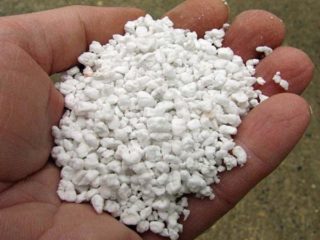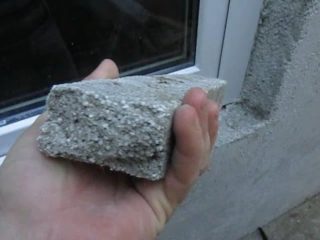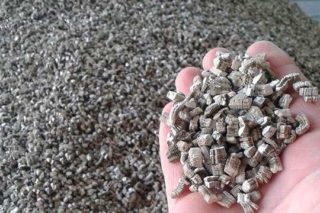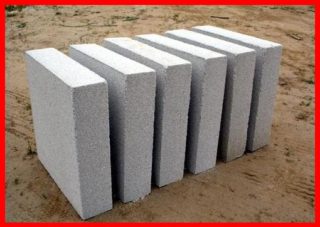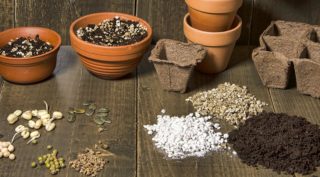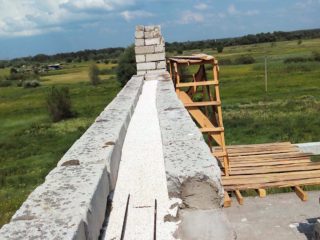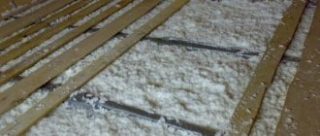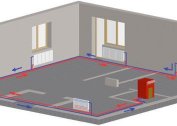During the construction of buildings, the problem arises of choosing high-quality thermal insulation. The material must have a long service life, low thermal conductivity and low cost. Perlite meets all the criteria. The bulk insulation of natural origin due to flowability is tightly packed and reduces energy loss by 30-50%.
Technical characteristics of a heater
Rocks form in a lava flow during a volcanic eruption. It is formed as a result of groundwater exposure to volcanic glass. The mineral has a specific structure and easily decomposes into separate rounded parts - pearls. Another distinctive feature of the porous rock is the water content of about 1% of the total volume.
In construction, expanded perlite insulation is used, which has undergone heat treatment in furnaces at a temperature of 1100 ° C. When heated, the moisture evaporates, giving the mineral a porous structure and increasing its size several times. The material becomes light, acquires heat-insulating properties. It is made with various sizes of fractions from fine sand to gravel. The sizes of building perlite are 0.16-1.25 mm, agroperlite is 1-5 mm. Perlite sand has a large dispersion in density - 40-200 kg / m3.
Specifications:
- thermal conductivity - 0,043-0,052 W / m * K;
- moisture content by weight - not more than 2%;
- uneven grain size - up to 15% by volume of the product;
- moisture absorption - up to 400% of its own weight.
The insulation is chemically neutral, not afraid of exposure to alkalis and weak acids. It does not rot under the influence of moisture, microorganisms and rodents do not live in it. The heat insulator is used in a wide temperature range from -200 ° C to + 900 ° C. The material is environmentally friendly for people, does not contain toxic impurities and heavy metals.
Pros and Cons of Perlite
When choosing a loose insulation, consumers have to compare several materials: expanded clay, expanded polystyrene granules, vermiculite or perlite. Each variety has features that are considered when making a decision. Bulk insulation made of volcanic glass is highly effective. The material does not shrink, like granular polystyrene foam, and does not get wet, like expanded clay. The main advantages of insulation are:
- Low thermal conductivity of perlite, which provides many voids of the porous structure of the mineral. Also, the structure of the mineral contributes to effective sound absorption.
- Light weight, allowing up to 40% to reduce the total weight of the structure. Lightweight bearing walls do not require a massive foundation.
- The ability to operate in different temperature ranges does not limit the use of the material.
- Resistance to fire guarantees fire safety of a heater. He is able to stop the spread of fire. When heated, does not emit smoke and toxic substances.
- Natural mineral is environmentally friendly, it contains no harmful impurities.
- Loose insulation evenly fills the space, fits tightly, without leaving cold bridges. The material does not cause difficulties when backfilling like foam granules.
Fragility is the main disadvantage of perlite. The mineral is easily destroyed, turning into dust. The material loses weight when transported in an open way, creates inconvenience during backfill. Working with it requires the use of protective equipment: respirators, goggles, gloves.So that sand is less dusty, it is moistened with water before use.
The ability of perlite to absorb moisture is not always a negative characteristic. He is able to easily give water in the form of steam. The material prevents condensation on the walls. For normal operation of the insulation, it is necessary to ensure that excess moisture is removed to the outside.
Comparison with vermiculite
Among bulk heaters, the choice is usually made of two minerals - agroperlite or vermiculite. An unambiguous conclusion can be made by comparing their characteristics. Vermiculite is a layered dense material. In construction, it is used in expanded form. The mineral is heated to a temperature above 1000 ° C, during processing it increases in volume up to 20 times.
A significant advantage of vermiculite is elasticity. Unlike perlite, it does not deform and does not crumble under the weight of its own weight. The heater is heat-resistant and environmentally friendly. High hygroscopicity of filling requires a high-quality ventilation device on the roof.
Physicotechnical properties of materials are similar to each other. Bulk materials differ in appearance: perlite is light, vermiculite is brown. The thermal insulation properties of perlite insulation are slightly higher than that of vermiculite. But the main factor in favor of a volcanic glass insulation is low cost. Material costs less than vermiculite 2-3 times, therefore it is more popular in construction.
Varieties of bulk insulation
Perlite insulation is available in various forms. It is recommended for the construction of residential buildings and industrial facilities, farm buildings. Depending on the type of material, it is added to the composition of the stucco mortar, is a backfill of the walls, or laid like ordinary boards. Material with a decorative coating is used as a cladding.
Slabs
Pressed boards are the most convenient form of using mineral rock. They are used for thermal insulation and fire protection of buildings. It is easy to work with plates, the appearance of dust characteristic of sand is excluded. In the manufacture of mineral raw materials mixed with cement, water glass or bitumen. The resulting material has low thermal conductivity, it is heat-resistant and durable. The insulation is divided by density into several grades. Material specifications are dependent on additives. Its advantages: light weight, soundproof qualities, durability.
Sand
This type of insulation is used as filling the voids in the walls, floors, floors. The most popular in construction is perlite sand of brands M-75, M-100, M-150. The material has a small weight that does not create excessive pressure on the base. The insulation is purchased in bags, from which filling is made into voids. The main advantages of perlite sand: fluidity, resistance to fire, chemical and biological inertness. The thermal conductivity of the material increases with increasing density of the backfill.
Dry mixes
Dry building mixtures based on expanded perlite are distinguished by enhanced thermal insulation properties. In addition to sand from volcanic rock, the composition includes cement or gypsum. To prepare the plaster mortar, it is enough to add water in the volume specified by the manufacturer. The mixture is used to warm the facade, interior work, create a decorative coating. The use of compounds in masonry mortar during the construction of walls from concrete blocks improves the thermophysical parameters of the structure. Perlite-based mortars are durable, non-combustible, and environmentally friendly.
Application area
In its natural form, the mineral is used in various economic fields:
- the food and medical industry uses the mineral as a cleaning filter;
- in agriculture, perlite disintegrants are popular.
In the construction of buildings usually use expanded perlite. It allows you to provide optimal indicators of sound and heat insulation of walls, floors, roofs. The insulation is effective for uniform filling and composition of insulating products. It is used to fill the masonry of external and internal walls, with the installation of a warm floor system, insulation of floors.
Wall insulation
Perlite is popular as a heater of walls of a frame house or a brick building, erected by the method of well masonry. The use of mineral filler reduces the cost of the overall construction estimate. The layer thickness depends on the climatic conditions of the region. It is calculated at the stage of preparing the construction project of the house.
Insulation with pearlite sand begins at the initial stage of walling. Its recommended bulk density is 60-100 kg / m3. When thermal insulation of the foundation and basement, sand is added to the plaster mixture. After masonry, the structure is covered with floor slabs. They are carefully sealed with a solution so that moisture does not enter the cracks.
Roof insulation
Perlite thermal insulation is used for insulation of a flat roof, attic and floor floors, floor. For roofs of complex shape created a special material - bitumen perlite. This is a composition of perlite sand and heated bitumen. The plates are given the desired shape. Among the advantages of the product are fire resistance and good heat-insulating characteristics. Perlite-bituminous materials can be used at low subzero temperatures.
Insulation technology
High hygroscopicity of the filling requires the installation of a waterproofing layer. An important condition is the use of only dry perlite. The width of the hole into which the mineral is poured depends on the climatic conditions of the region. It is at least 15-20 cm. During the construction process, perlite is poured into the inter-wall space gradually, after the construction of 4-5 rows of bricks or concrete blocks. Tamping is done by tapping with a wooden hammer. The flowability of the material in this case is a useful property. It fits tightly without leaving voids.
When warming the floors, a plasterboard or chipboard floor is laid first on the base. The thickness of the backfill layer is at least 1 cm. It is covered with kraft paper or cardboard. Cellulosic materials do not inhibit moisture evaporation. For pitched roofs, perlite-bitumen slabs are used.
